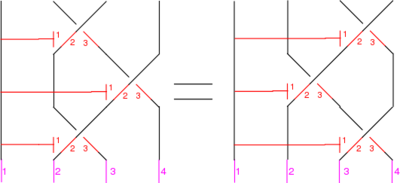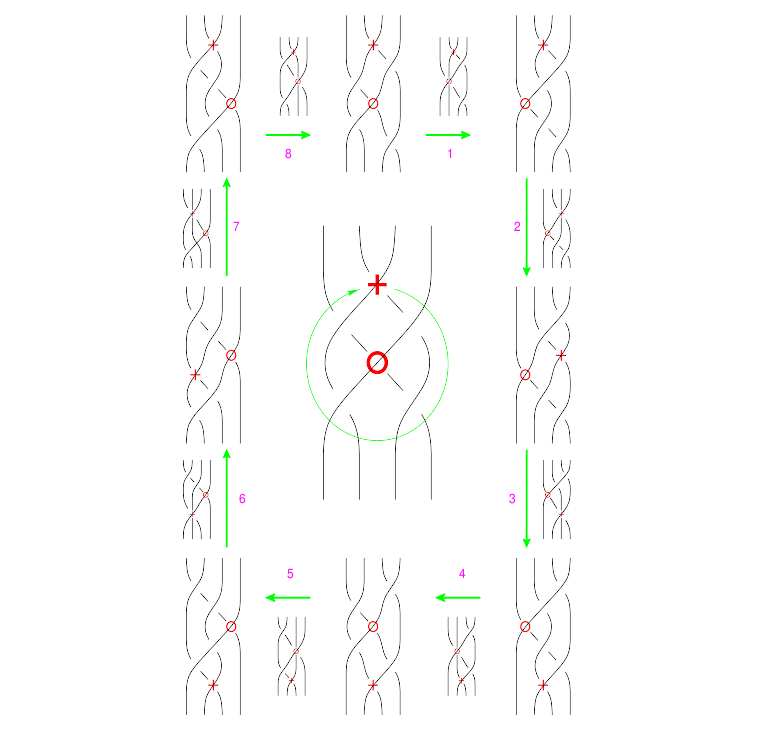|
|
| Line 111: |
Line 111: |
|
|
|
|
|
|
|
|
|
What I will do now is linearize and write down in functional form the relation R2 |
|
What I will do now is linearize and write down in functional form the relation R2. We know R2 correspnds to <math>(123)^\star B^\pm\cdot(132)^\star B^\mp=1_3</math>. Rewriting it gives, |
|
|
|
|
|
{| align=center |
|
{| align=center |
Latest revision as of 20:38, 2 December 2006
The Generators
Our generators are  ,
,  ,
,  and
and  :
:
| Picture
|
|
|
|

|
|
| Generator
|

|

|

|

|

|
| Perturbation
|

|

|

|

|

|
The Relations
The Reidemeister Move R3
The picture (with three sides of the shielding removed) is
In formulas, this is
 .
.
Linearized and written in functional form, this becomes

|

|
|
|

|
The Syzygies
The "B around B" Syzygy
The picture, with all shielding removed, is
|
|
(Drawn with Inkscape)
(note that lower quality pictures are also acceptable)
|
The functional form of this syzygy is

|

|
|
|

|
|
|

|
A Mathematica Verification
The following simulated Mathematica session proves that for our single relation and single syzygy,  . Copy paste it into a live Mathematica session to see that it's right!
. Copy paste it into a live Mathematica session to see that it's right!
In[1]:=
|
d1 = {
rho3[x1_, x2_, x3_, x4_] :> bp[x1, x2, x3] + bp[x1 + x3, x2, x4] +
bp[x1, x3, x4] - bp[x1 + x2, x3, x4] - bp[x1, x2, x4] -
bp[x1 + x4, x2, x3]
};
d2 = {
BAroundB[x1_, x2_, x3_, x4_, x5_] :> rho3[x1, x2, x3, x5] +
rho3[x1 + x5, x2, x3, x4] - rho3[x1 + x2, x3, x4, x5] -
rho3[x1, x2, x4, x5] - rho3[x1 + x4, x2, x3, x5] -
rho3[x1, x2, x3, x4] + rho3[x1, x3, x4, x5] +
rho3[x1 + x3, x2, x4, x5]
};
|
In[3]:=
|
BAroundB[x1, x2, x3, x4, x5] /. d2
|
Out[3]=
|
- rho3[x1, x2, x3, x4] + rho3[x1, x2, x3, x5] - rho3[x1, x2, x4, x5]
+ rho3[x1, x3, x4, x5] - rho3[x1 + x2, x3, x4, x5]
+ rho3[x1 + x3, x2, x4, x5] - rho3[x1 + x4, x2, x3, x5]
+ rho3[x1 + x5, x2, x3, x4]
|
In[4]:=
|
BAroundB[x1, x2, x3, x4, x5] /. d2 /. d1
|
Out[4]=
|
0
|
Here Goes Something New(?)
The first thing to notice is that the relation  holds for
holds for  and
and  so we have another version:
so we have another version:

|

|
|
|

|
This is probably a completely trivial remark, and it is also trivial to see that mathematica will deal with this in the same way as for  so I won't verify that
so I won't verify that  .
.
What I will do now is linearize and write down in functional form the relation R2. We know R2 correspnds to  . Rewriting it gives,
. Rewriting it gives,

|

|
or

|

|





























